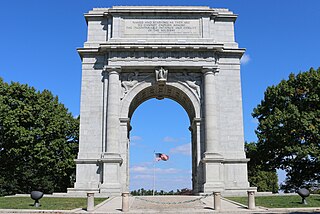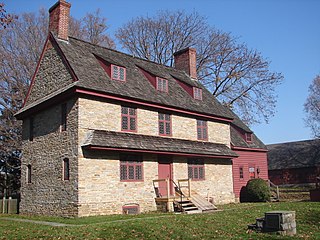
Valley Forge National Historical Park is the site of the third winter encampment of the Continental Army during the American Revolutionary War from December 19, 1777 to June 19, 1778. The National Park Service preserves the site and interprets the history of the Valley Forge encampment. The park contains historical buildings, recreated encampment structures, memorials, museums, and recreation facilities.

The Mercer Museum is a museum located in Doylestown, Pennsylvania. The Bucks County Historical Society operates the Mercer Museum, the Research Library, and Fonthill Castle, the former home of the museum's founder, archeologist Henry Chapman Mercer.

Old Fort Johnson is a historic house museum and historic site at 2 Mergner Road in Fort Johnson, New York. It is the site of Fort Johnson, a two-story stone house originally enclosed in fortifications built by Sir William Johnson about 1749. The fort served as Johnson's home, business office and trading center until 1763 when he moved to Johnson Hall in what is now Johnstown, New York. Sir William's son Sir John Johnson owned the house from 1763 until 1776, when it was confiscated by the local Committee of Safety. The house remains and is owned and operated as a museum by the Montgomery County Historical Society. It was designated a National Historic Landmark in 1972.

The Allegheny County Courthouse in downtown Pittsburgh, Pennsylvania, is part of a complex designed by H. H. Richardson. The buildings are considered among the finest examples of the Romanesque Revival style for which Richardson is well known.

Carpenters' Hall is the official birthplace of the Commonwealth of Pennsylvania and a key meeting place in the early history of the United States. Carpenters' Hall is located in Independence National Historical Park in Philadelphia, Pennsylvania. Completed in 1775, the two-story brick meeting hall was built for and still privately owned by the Carpenters' Company of the City and County of Philadelphia, the country's oldest extant craft guild.

The William Brinton 1704 House is an historic house museum which is located at 21 Oakland Road in Delaware County, Pennsylvania, roughly five miles south of West Chester, Pennsylvania. Built in 1704, it is a well-preserved example of an early Delaware Valley stone house that served as a residence of one family for more than 150 years.

Washington's Headquarters at Valley Forge, also known as the Isaac Potts House, is a historic house that served as General George Washington's headquarters at Valley Forge during the American Revolutionary War. The building, which still stands, is one of the centerpieces of Valley Forge National Historical Park in Southeastern Pennsylvania.

Mill Grove is a historic house and estate on Pawlings Road in Audubon, Pennsylvania. Built in the 1760s, it is notable as the first home in America of painter and naturalist John James Audubon (1785-1851), for whom the community is named. The 130-acre (53 ha) estate is now maintained as a museum and wildlife sanctuary by Montgomery County, and was designated a National Historic Landmark in 1989. The house serves as the educational center of the Pennsylvania chapter of the National Audubon Society, and is known as John James Audubon Center at Mill Grove.

Augustus Lutheran Church is a historic church and Lutheran congregation at 717 West Main Street in Trappe, Pennsylvania. Consecrated in 1745, it is the oldest extant Lutheran church building in the United States. It continues to be used by the founding congregation for services on Christmas Eve and during the summer. It was designated a National Historic Landmark in 1967.

Waynesborough, also known as the Gen. Anthony Wayne House, is a historic house museum at 2049 Waynesborough Road in Easttown Township, Chester County, Pennsylvania. Built in 1724 and repeatedly enlarged, it was for many years the home of American Revolutionary War general Anthony Wayne (1745–1796). A National Historic Landmark, it is now a museum operated by the Philadelphia Society for the Preservation of Landmarks, offering tours and event rentals.

The Merion Friends Meeting House is an active and historic Quaker meeting house at 615 Montgomery Avenue in Merion Station, Pennsylvania. Completed about 1715, it is the second oldest Friends meeting house in the United States, with distinctively Welsh architectural features that distinguish it from later meeting houses. It is home to the Merion monthly meeting. The meeting house was declared a National Historic Landmark in 1999.

Summerseat, also known as the George Clymer House and Thomas Barclay House, is a historic house museum at Hillcrest and Legion Avenues in Morrisville, Bucks County, Pennsylvania. Built about 1765, it is the only house known to have been owned by two signers of the United States Declaration of Independence, Founding Fathers George Clymer and Robert Morris, and as a headquarters of General George Washington during the American Revolutionary War. The house is now managed by the Morrisville Historical Society, which offers tours. It was designated a National Historic Landmark in 1965.

Woodville, also known as the Neville House or John Neville House, is a house which is located on Washington Pike south of Heidelberg, Pennsylvania. It is significant for its association with John Neville, a tax collector whose other house was burned in the Whiskey Rebellion in 1794. The oldest portion of the house dates to 1775, with a main section built a decade later.

The General Friedrich Von Steuben Headquarters is a historic house on Pennsylvania Route 23 in Valley Forge National Historical Park in Chester County, Pennsylvania. Built about 1770, it has been advanced as a possible residence of Baron Friedrich von Steuben (1730-1794), the Prussian drill-master of Continental Army troops during the 1777-78 Valley Forge encampment. The house, which is a partial reconstruction, was declared a National Historic Landmark in 1972.

Schifferstadt, Also known as Scheifferstadt, is the oldest standing house in Frederick, Maryland. Built in 1758, it is one of the nation's finest examples of German-Georgian colonial architecture. It was designated a National Historic Landmark in 2016.
Henry Antes was an early 18th-century settler of Pennsylvania, an architect and builder and a leader of the Congregation of God in the Spirit and then the Moravian Church. He is considered one of the most important religious/political leaders of the time, specifically because he preached tolerance and understanding.

The 1803 House, also known as the Jacob Ehrenhardt Jr. House, is a historic home located in Emmaus, Pennsylvania. It was built in 1803 for Jacob Ehrenhardt Jr., a son of one of the town's founders.

Dawesfield, also known as Camp Morris, is an historic country house estate located in Ambler in Whitpain Township, Montgomery County, Pennsylvania. The property has eleven contributing buildings, one contributing site, and one contributing structure. They include the two-and-one-half-story, stone main dwelling, stone barn, stone tenant house (1845), frame farm manager's house (1884), and eight stone-and-frame outbuildings (1736-1952). The property features landscaped grounds, a stone wall, and terraced lawns.

Fonthill, Mercer Museum and Moravian Pottery and Tile Works is a National Historic Landmark District located at Doylestown, Bucks County, Pennsylvania. It consists of three properties built by Henry Chapman Mercer (1856-1930) in a distinctive application of the principles of the Arts and Crafts movement, which are also notable for the early use of poured concrete: Fonthill, the Mercer Museum, and the Moravian Pottery and Tile Works. All three are now museum properties of the Bucks County Historical Society. The landmark designation for the group was made in 1985; each property is also individually listed on the National Register of Historic Places.

The Reading Furnace Historic District is a national historic district that is located in Warwick Township and East Nantmeal Township, Chester County, Pennsylvania.























